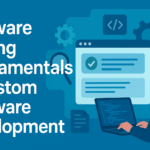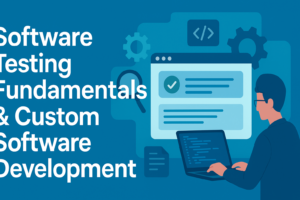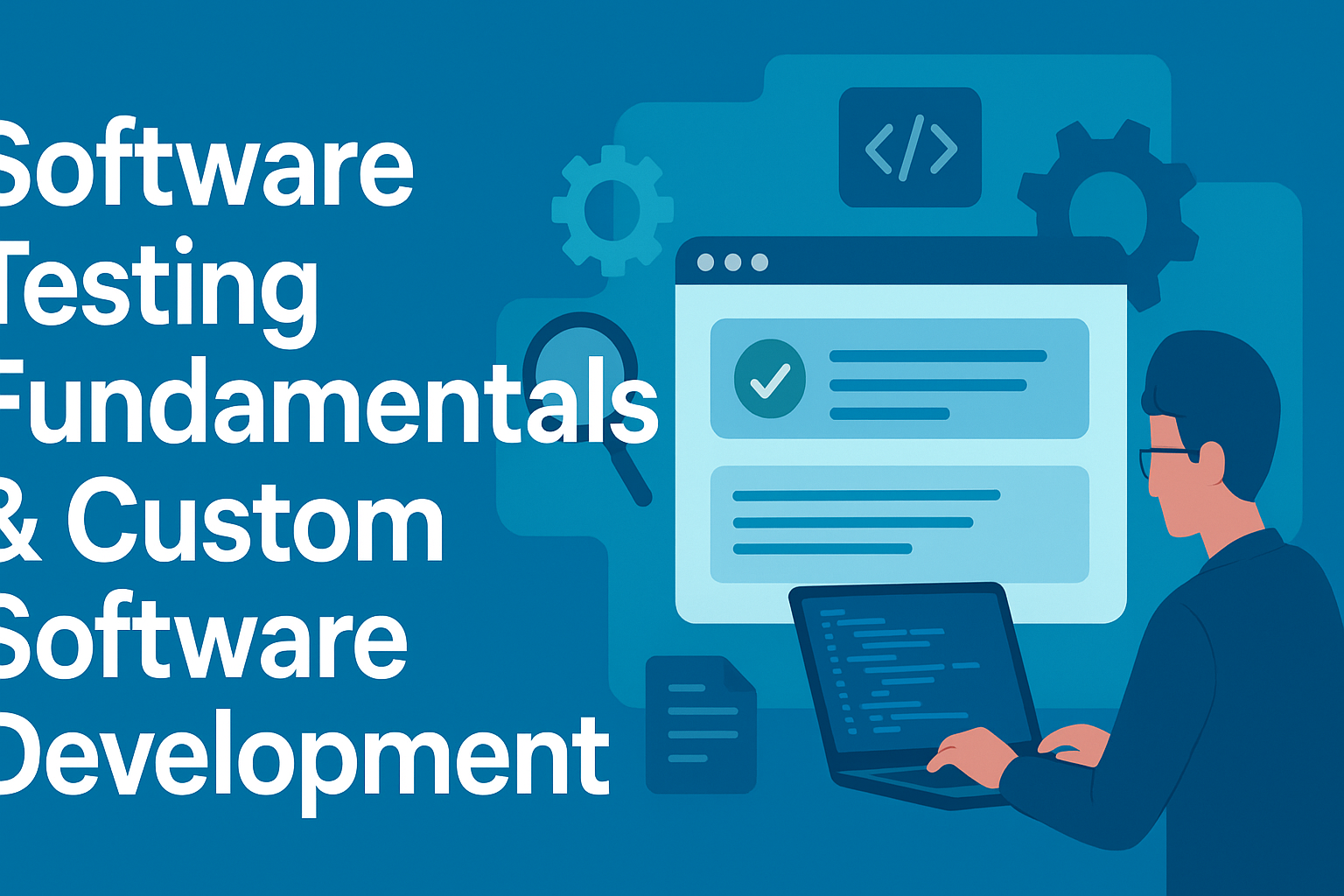Organizations in today’s digital environment require software that not only functions properly but also suits their specific business objectives. It is necessary to grasp software testing fundamentals and how custom software development can meet specific requirements for small and medium-sized businesses. This article will define the software testing basics, discuss the merits of custom software development, and identify functional areas where customized solutions have an impact, such as small biz management software, enterprise software risk, manufacturing software, and portfolio management software. The principles of software testing, the importance of custom software development, and real-world applications where customized solutions are useful—such as portfolio management software, manufacturing software, and small business management software—will all be covered in this article.
What are Software Testing Basics?
Software testing basics constitute the foundation of providing high-quality software. Testing involves testing a system to detect defects and ensure it fulfills requirements. Some of the most important concepts include

- Test levels: unit testing, integration testing, system testing, and acceptance testing.
- Types of testing: functional testing, non-functional testing (performance, security, usability), and regression testing.
- Test design methods: boundary value analysis, equivalence partitioning, and risk-based testing.
- Defect management: defect logging, defect tracking, defect prioritizing, and retesting defects.
- Quality assurance vs. testing: QA is concerned with process and standards, whereas testing is concerned with product validation.
- Automated testing: applying tools to run repetitive tests, enhance coverage, and speed up feedback loops.
Why software testing fundamentals are important:
- Early defect detection saves expensive rework.
- Precise test cases provide reproducibility and accountability.
- Comprehensive testing establishes user trust and product dependability.
- Automation augments manual testing to ensure consistency from release to release.
The Value of Custom Software Development
Custom software development services mean creating software to the unique processes, data models, and objectives of a company. Custom software does not mimic the one-size-fits-all nature of off-the-shelf offerings, but instead is crafted to suit a business’s own shape, allowing for improved alignment with business strategy. Top 10 Offshore App Development Companies in 2025 (Source: InnovaeSoft.com)
Advantages of Custom Software Development
- Targeted functionality: Capabilities specifically matched to business processes.
- Scalability: Architecture that expands as the organization grows.
- Competitive differentiation: Capabilities that are distinctive and differ from competitors.
- Better user adoption: Easy-to-use interfaces tailored to real users.
- Integration readiness: Smooth integration with current systems and data sources.
Key Considerations When Pursuing Custom Software Development
- Requirements gathering: Interviews with stakeholders, process mapping, and prioritization.
- Architecture and technology stack: Selecting languages, frameworks, and cloud vs. on-premises.
- Security and compliance: Inclusion of security by design and compliance with industry regulations.
- Maintenance and evolution: Consideration of updates, support, and future development.
- Total cost of ownership: Managing upfront investment in relation to long-term value.
Domains Where Custom Solutions Shine
Custom software development can be applied to a variety of business requirements in various industries. Following are some representative industries and examples:
Small Biz Management Software
- Purpose-built applications for managing CRM, invoicing, inventory, and project tracking in a single integrated system.
- Benefits: Streamlined processes, enhanced cash flow visibility, and enhanced customer service.
Manufacturing Software
- Custom applications for production planning, shop floor tracking, quality control, and maintenance management.
- Benefits: Downtime reduction, optimized production cycles, and enhanced traceability.
Portfolio Management Software
- Systems to administer a portfolio of projects or investments, with dashboards at the portfolio level, risk analysis, and resource management.
- Advantages: Decision-making based on information, alignment with strategic objectives, and balanced risk-reward ratios.
Enterprise Software:
- Enterprise-scale systems intended to address enterprise-wide processes, data management, and analytics.
- Advantages: Interdepartmental consistency, centralized data, and scalability of analytics.
Risk Management Software
- Applications to find, evaluate, and mitigate risks in operations, compliance, and IT.
- Advantages: Forward-looking risk management, auditability, and regulatory compliance.
How Software Testing is Embedded with Custom Development
Embedding software testing early and across the development cycle is essential for successful custom software development. Some of the important practices are:
- Requirements-driven testing: Develop test cases based on written requirements to achieve coverage.
- Continuous testing: Embed automated tests into CI/CD pipelines to offer quick feedback.
- Test plan and strategy: Establish risk-based testing priorities to prioritize high-impact areas like core business workflows and data integrity.
- Non-functional testing: Test performance under expected load, security robustness, and accessibility.
- Change management: Make regression tests part of every enhancement or bug fix.
- Validation with stakeholders: Engage end-users and domain experts to ensure the software fulfills actual needs.
Best Practices for Delivering Successful Custom Projects
- Begin with a clear product vision: Establish business objectives, success factors, and cutover plans.
- Value-prioritize, not feature-prioritize: Prioritize what brings measurable value to users and the business.
- Invest in a solid QA plan: Leverage automated tests in combination with manual testing to address critical paths.
- Seize modular architecture: Design components that can change separately, allowing for future adjustments.
- Data integrity and migration planning: Plan data models and migration routes that reduce risk.
- Governance and risk management: Define clear ownership, decision rights, and compliance controls.
- Transparent communication: Keep the stakeholders in the loop with open channels, regular updates, and demos.
Real-World Scenarios and Considerations
- Small Biz Management Software: One interface is required by a business owner for invoicing, managing clients, and tracking projects. A bespoke solution can mirror unique invoicing regulations, commissioning frameworks, and onboarding processes, with precision-crafted automated tests guaranteeing accuracy through upgrades.
- Manufacturing Software: A mid-sized manufacturer needs shop floor visibility, maintenance planning, and quality checks. Custom software will be integrated with current ERP and MES systems, with testing concentrated in data integrity, real-time, and failover under production spikes.
- Portfolio Management Software: An investment company needs a dashboard-based solution to track various projects or funds, with risk dashboards and resource planning. Custom development allows unique risk metrics, report formats, and role-based secure access, with extensive testing around report accuracy and data aggregation.
- Enterprise Software & Risk Management: Enterprise-scale solutions are frequently required by large organizations to consolidate operations and apply governance. Custom software enables customization of workflows, audit trails, and regulatory controls, with testing focusing on security, scalability, and compliance auditing.
Establishing a Quality-First Custom Software Delivery Model
An effective model merges software testing fundamentals with agile development techniques:
- Define testing personas: Develop test cases that accurately represent actual user roles and responsibilities.
- Automate early: Begin with critical paths and scale up as features increase.
- Sustain test data strategies: Employ representative, privacy-aware data sets for testing.
- Invest in performance baselines: Create acceptable boundaries early and track against them.
- Perform regular reviews: Align with business stakeholders on changing requirements and quality targets.
Conclusion
Software testing fundamentals, applied to custom software development, enable organizations to create solutions that really suit their processes and objectives. Whether you’re developing small biz management software, manufacturing software, or portfolio management software, a disciplined testing approach coupled with thoughtful design and governance yields reliable, scalable, and competitive software. By choosing custom software development services that emphasize quality, security, and usability, businesses can achieve a stronger return on investment and a more cohesive technology ecosystem.
Author
Jabran Mustafa is an accomplished technology writer specializing in IT, SaaS, and software development. Launching his writing journey in 2022, he brings over three years of dedicated experience in delivering insightful, industry-leading content. Since 2024, he has been a key contributor to innovaesoft.com, where he consistently provides in-depth analysis and innovative perspectives. With a passion for demystifying complex tech concepts, Jabran work aims to empower professionals and catalyze digital transformation.

















